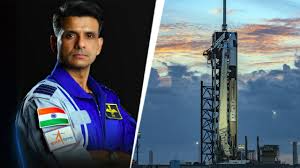What Shubhanshu Shukla said after lift-off of Axiom-4 Mission

In a moment that echoed through the hearts of 1.4 billion Indians, Group Captain Shubhanshu Shukla delivered an emotional message from space that signaled not just the success of a mission, but the rebirth of a nation’s manned spaceflight aspirations. Riding aboard Axiom Space’s Ax-4 mission, Shukla became the face of India’s new era in human space exploration, and his powerful words just ten minutes after launch are already being etched into history.
“Namaskar, my dear countrymen. What a ride…”
These were the first words that beamed down from space as Shukla began his message, his voice steady yet charged with emotion. Speaking directly to the people of India, he said,
“After 41 years, we are back in space. What a flight this is.”
With those few words, he honored the legacy of Rakesh Sharma, who in 1984 became the first Indian in space. But instead of dwelling on the past, Shukla’s message looked firmly toward the future.
A Symbolic Moment: More Than a Mission
Shukla, wearing his spacesuit with the Tiranga (Indian tricolor) on his shoulder, emphasized,
“On my shoulders is the Indian tricolour that tells me I am not alone — all of you are with me.”
This wasn’t just a symbolic statement. It was a declaration that India’s journey to the stars would no longer be a solitary dream but a collective ambition. His presence aboard a privately managed international spaceflight marks a pivotal moment — one where Indian astronauts are not just participating in global missions but preparing to lead their own.
India’s Human Spaceflight Programme Takes Flight
As Shukla eloquently stated,
“This journey to the International Space Station is not mine alone; it’s the beginning of India’s human spaceflight programme.”
While India’s space agency ISRO has been making headlines for its Chandrayaan and Mangalyaan missions, the Gaganyaan programme — India’s first indigenous manned space mission — is still in development. Shukla’s mission on Ax-4 thus serves as a vital training ground, testing human endurance, microgravity science, and astronaut coordination in space environments.
The message wasn’t just about scientific milestones — it was about involving the Indian people in the excitement of this journey.
“You should feel proud, you should feel the excitement. Come, let’s together mark the beginning of India’s human spaceflight programme.”
Carrying Forward a Legacy, Creating a New One
It’s been 41 years since Rakesh Sharma famously told then Prime Minister Indira Gandhi that “India looks best from space.” Now, Shukla steps into those same celestial footsteps with a mission that reflects modern India’s strength, ambition, and international collaborations.
While Rakesh Sharma flew on a Soviet spacecraft as part of the Interkosmos programme, Shukla’s participation in Ax-4 reflects India’s ability to collaborate with global private players like Axiom Space while preparing for its own sovereign missions.
Who Is Shubhanshu Shukla?
Group Captain Shubhanshu Shukla is a decorated Indian Air Force officer and one of the chosen few for India’s future space missions. Trained as a test pilot and later selected by ISRO for its astronaut training programme, Shukla has undergone rigorous preparation — including sessions in Russia, India, and the US — to be spaceflight-ready.
This mission is not just a personal milestone but a testbed for India’s forthcoming astronaut candidates. Shukla’s calm, commanding presence and his choice to speak in Hindi, directly addressing the Indian public, further solidified his role as a relatable space ambassador.
The Power of Words From Space
In less than a minute, Shukla connected with a nation that has long dreamed of a space renaissance. His heartfelt message — part speech, part invitation — carried more weight than any technical briefing or diplomatic statement.
“Thank you. Jai Hind. Jai Bharat.”
These final words, beamed from hundreds of kilometers above Earth, felt grounded in national pride and hope.
Axiom-4 Mission: A Launchpad for Indian Aspirations
The Ax-4 mission itself, operated by Axiom Space and launched aboard a SpaceX Falcon 9, is part of a growing trend in commercial spaceflight that includes civilian astronauts and international scientific collaborations. For India, this mission serves several strategic goals:
- Human readiness testing: Understanding how Indian astronauts respond to extended microgravity.
- Data for Gaganyaan: Insights that can help ISRO fine-tune India’s own manned mission plans.
- Global partnerships: Reinforcing India’s reputation as a rising space power ready for joint ventures.
The Road Ahead for India’s Space Journey
With Shukla’s mission successfully launched, all eyes are now on the Gaganyaan mission, expected to launch soon with a crew of 2–3 Indian astronauts for a low Earth orbit mission. This indigenous mission, combined with partnerships like Ax-4, will define India’s space presence for the next decade.
Meanwhile, ISRO continues to expand its satellite and interplanetary programmes, with Mars 2.0, Shukrayaan (Venus mission), and space-based solar observatories in the pipeline.
Conclusion: A Moment That Belongs to All of India
Shubhanshu Shukla’s brief but powerful message after the Ax-4 lift-off wasn’t just a technical update — it was a national moment of pride. He became a bridge between the dreams of the 1980s and the ambitions of 21st-century India. His words have ignited imaginations, reassured ISRO’s visionaries, and reminded the world that India is not just watching the space race — it is actively shaping it.
As millions of Indians replay his spaceborne words, one truth is clear: the journey to space has never felt more personal, more collective, or more Indian.






